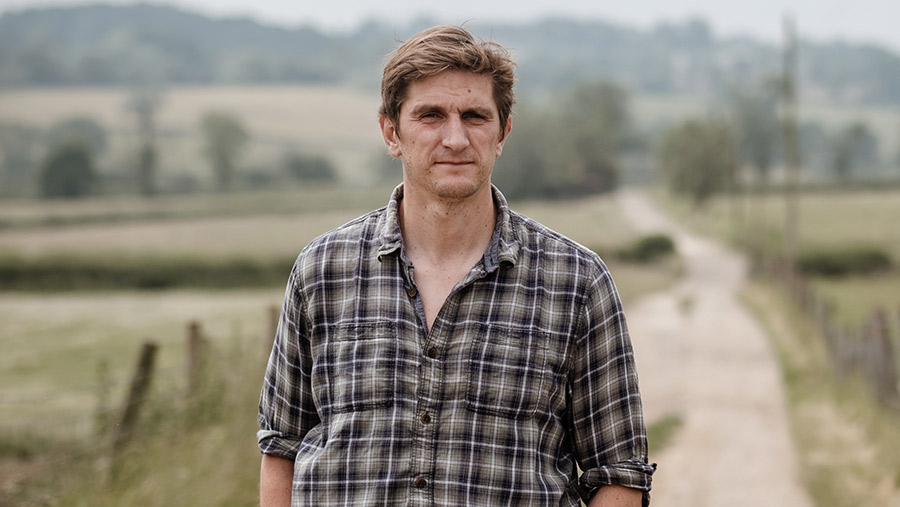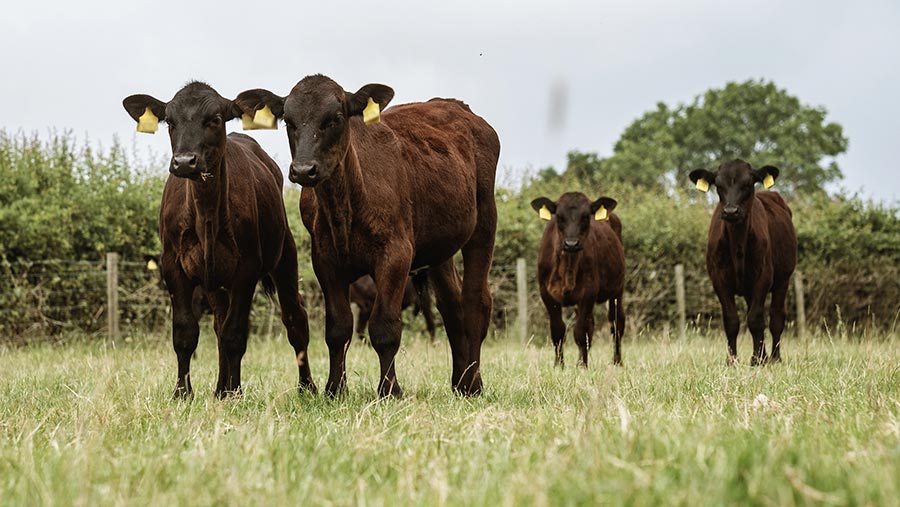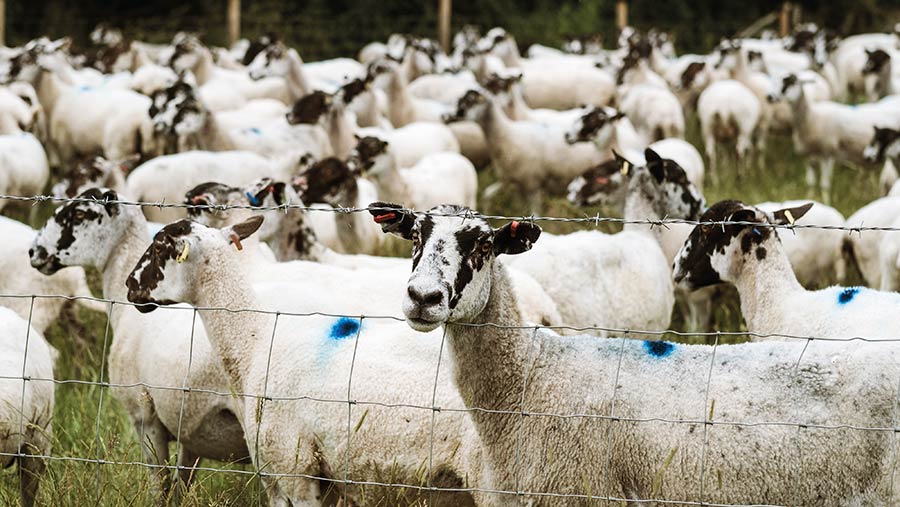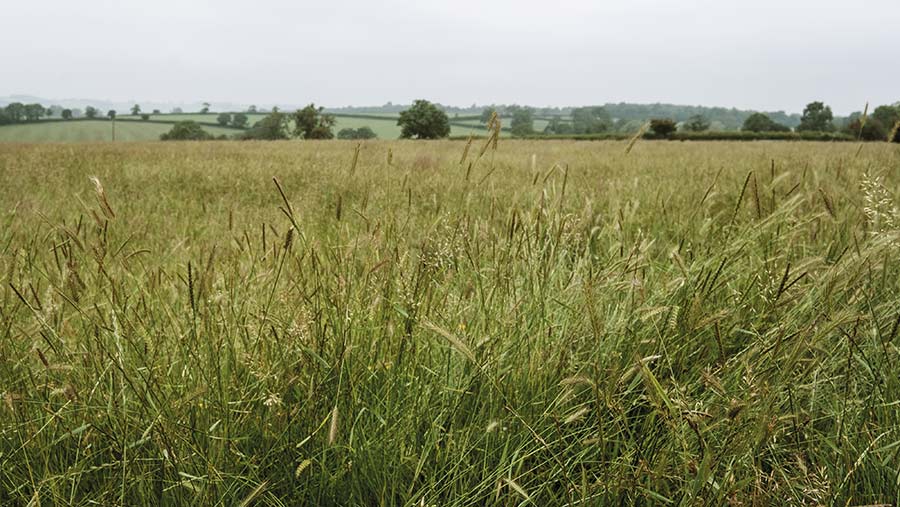How one farm hopes to balance financial and environmental demands
 © MAG/Colin Miller
© MAG/Colin Miller Transition Farmer James MacCartney says the size of his farm is the main challenge he faces in his quest to secure a sustainable future for his business.
A third-generation beef and sheep producer, Mr MacCartney farms in partnership with his mother, Lesley, and sister, Abigail, at Flitteriss Park Farm, Braunston, near Oakham in Rutland.
The 160ha farm is home to 600 breeding ewes and 150 cattle, which are purchased as calves and then fattened.
With his wife Peta due to give birth to their first baby this autumn, Mr MacCartney says he needs a better return from the business.
See also: Regenerative farming helps cut beef and sheep risk
Having studied for a degree in rural land management at the Royal Agricultural University, Cirencester, Mr MacCartney returned home and took on responsibility for the family’s sheep and beef enterprises 10 years ago.
Farm facts
Flitteriss Park Farm, Braunston, Oakham, Rutland
- Farm size: 160ha
- Annual rainfall: 720mm
- Soil type: Heavy clay
“My goal is to have a business that is profitable. That means making what we do way more productive.
“It’s not enough for our enterprises just to be washing their own face – we need to be much better than that.”
Firm in his belief that financial and environmental sustainability are tightly linked, Mr MacCartney says you can’t have one without the other.
“It’s about getting the balance right – that’s what we are striving to achieve.”
Mindful that increasing the farm size is easier said than done, Mr MacCartney is instead focusing his efforts on making every asset earn its keep.
This includes the core farm enterprises, farm diversifications, and the surrounding countryside.
Transition goals
- Reducing carbon footprint
- Reaching disease-free status
- Establishing herbal leys
Disease management
“The challenge for both our livestock enterprises is disease management,” he explains.
“We are tackling it on a daily basis and it has improved dramatically over recent years. But there is still room for improvement.”
Having experienced bovine TB in the past, the farm has switched from purchasing cattle through an auction mart to sourcing calves direct from two local dairy farms at four weeks old, and then fattening them.

© MAG/Colin Miller
“It means we are able to choose exactly the calves we want and it is working really well for us,” he says. “The calves stay on the farm their whole life.”
Sheep are proving more tricky. Mr MacCartney would like to expand the flock to 1,200 ewes because the farm is understocked. But productivity is being limited by the presence of maedi visna (MV), a viral disease for which there is no cure or vaccine.
A strict testing and culling regime has been introduced to get on top of the problem. Once it is complete, Mr MacCartney hopes to join the MV-free accreditation scheme.
He will then expand the flock, and start breeding and selling his own replacements.

© MAG/Colin Miller
Herbal leys
Better herbal leys are another challenge. The farm is in Countryside Stewardship and has twice sown GS4 legume and herb-rich swards. But establishment is proving difficult.
The first ley failed and is patchy at best second time around.
“We have not managed to do this as successfully as I would like. It’s one of our stewardship options and we want to continue growing in the future, but we have really struggled to get it established.”
Herbal leys could be a big benefit – but only if they work, he adds. They would boost the productivity of both the beef and sheep enterprises, while improving soil structure and water infiltration.
“For the past two years, we have had to redrill the same field. I am not convinced it is completely practical on our farm.
“We are on very heavy land and most of it needs lime – a lot of the legume species prefer neutral to alkaline soils.”

© MAG/Colin Miller
Better than net zero
Success with herbal leys would also help Mr MacCartney reach his overall goal of being “better than net zero”.
The sustainability of any farm business is key, but “personally I am aiming for more than that”, he adds.
As part of this quest, this year he has embarked on a Nuffield Farming Scholarship.
It will see him investigate how UK red meat producers can win the battle for environmental sustainability in the minds of British consumers.
Covid restrictions permitting, the study tour will include a visit to the US, where Mr MacCartney hopes to learn from the “mistakes” of feedlot-style beef production, and to New Zealand, where he will look at sheep production.
“As an industry, I believe it is important to focus on ways we can make sure the improvements we make satisfy the concerns of the consumer – that UK red meat is an environmentally sustainable product,” he says.
Pumpkins and sunflowers
Alongside the main enterprises, the farm has diversified into holiday accommodation and outside catering.
Sister Abigail has her own farm business, Livelab – an independent testing facility providing services to the agricultural sector.
More recently, the farm has embarked on a successful pick-your-own pumpkin enterprise, and is now growing sunflowers, too.
“We grew 8,000 pumpkins last year, and sold them all in four days. Peta did all the marketing by social media.
“We had to turn away 2,500 people because we sold out – so we’re doubling the area this year.”
“As well as picking them, people were coming to have their photos taken with the pumpkins so they could post pictures on Instagram.
“The local countryside in a photo is a real asset for us that people in towns don’t have and we want to make the most of it.
“We hope to get a temporary alcohol licence so people can come and enjoy a picnic when the sunflowers are in bloom.
“The idea is for prosecco and local beers on picnic benches in one of the fields in front, with sunflowers as a backdrop. It’s about making the most of all our assets.”
Expert views on James MacCartney’s challenges
Rebecca Davenport, veterinary surgeon, Rutland Veterinary Centre
Buying in calves from a single source can be difficult – but it has improved animal health and welfare on the farm.
It has massively helped to reduce antibiotics use, mainly for cases of pneumonia on James’s farm.
There is always room for improvement. Vaccinating all bought-in livestock – both on arrival and as they are going through the system – has helped to prevent a lot of diseases and we have seen better weight gain.
The biggest challenge is the maedi visna status of sheep. The difficulty is that you often can’t see it until later on.
We are screening for the disease, isolating infected stock and culling them out while keeping clean stock separate.
We conduct an annual farm health review – but we are also in constant contact, either over the phone or via WhatsApp, rather than relying on a single meeting once a year.
It means we are able to pre-empt a lot of problems.
Ben Wixey, grassland adviser, Germinal
Herbal leys have many advantages – but they can be difficult to establish.
They are good for ruminants, and their anthelmintic properties can reduce worm burdens in livestock. Liveweight gain in younger animals can be particularly impressive.
Legumes help fix nitrogen, and the mix of different rooting plants benefits soil structure.
And from an environmental point of view, flowering plants provide both a habitat and food source for invertebrates and pollinators.
Having said that, ley multispecies need to be carefully established. Plants are not as aggressive as modern perennials, and you must have the right conditions.
Some of the seeds, such as yarrow, are so fine they are almost a dust.
The seed-bed must be fine, and you need good soil-to-seed contact. The soil must be warm and needs to be above pH6.
You need good moisture at drilling time and often throughout the establishment phase.
Liz Genever, beef and sheep consultant
Discussion groups are a good way of exchanging knowledge. It’s about a shared experience – talking to other farmers means you can pick up ideas you haven’t thought of.
The Welland group James belongs to is a great example because everyone knows each other.
The challenge for me is to keep pushing it on as a business development group – encouraging them to share performance figures, not just be social.
Technical efficiencies can be made on every farm. It’s about prioritising where you are best placed to pitch your efforts – the two or three things you can achieve that year, rather than trying to do everything at once.
It’s about positive change and being confident about the information you share. There are lots of ways of motivating people.
But the end goal is all the same – where are you now and where do you need to be?
James MacCartney is one of our Transition Farmers. Join them as they strive to become financially and environmentally sustainable and how they intend to overcome the challenges they face over the next five years.
